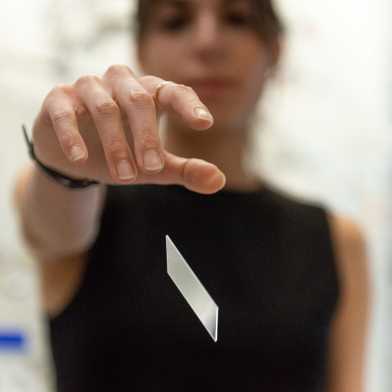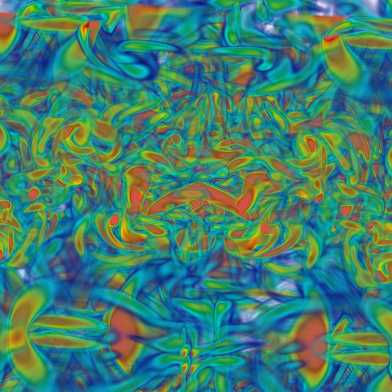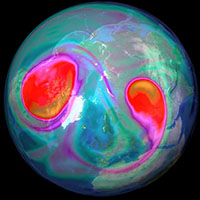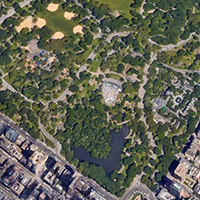ETH News
All stories that have been tagged with Computational sciences
Sunken worlds under the Pacific?

Geophysicists at ETH Zurich are using models of the lower mantle to identify areas where earthquake waves behave differently than previously assumed. This indicates the presence of zones of rocks that are colder, or have a different composition, than the surrounding rocks. This finding challenges our current understanding of the Earth's plate tectonics – and presents the researchers with a major mystery.
A stiff material that stops vibrations and noise
News

Materials researchers have created a new composite material that combines two incompatible properties: stiff yet with a high damping capacity.
How the plant world shapes the climate cycle
News

In order to understand the Earth's resilience, researchers at ETH Zurich are modelling climate changes from times long past. And they show: Plants are not simply victims of circumstances, but have helped to shape climate conditions on Earth.
The seas are in extremis
- News
- Zukunftsblog

An extraordinary heat wave is assailing the world’s oceans with an intensity that is surprising climate researchers. Environmental physicist Nicolas Gruber provides some context.
How drugs get into the blood
- News
- Homepage

Computer simulations have helped researchers understand in detail how pharmaceutically active substances cross cell membranes. These findings can now be used to discover new drug candidates more efficiently.
Precursor of spine and brain forms passively
News

Researchers at ETH Zurich have conducted a detailed study of neurulation – how the neural tube forms during embryonic development. They conclude that this happens less actively than previously thought. This also has implications for understanding defects such as spina bifida.
Bacteria with recording function capture gut health status
News

Researchers from ETH Zurich, University Hospital of Bern and the University of Bern have equipped gut bacteria with data logger functionality as a way of monitoring which genes are active in the bacteria. These microorganisms could one day offer a noninvasive means of diagnosing disease or assessing the impact of a diet on health.
Automated analysis of animal behaviour
News

Researchers have developed a new method that uses artificial intelligence to analyse animal behaviour. This opens the door to longer-term in-depth studies in the field of behavioural science – while also helping to improve animal welfare. The method is already being tested at Zurich Zoo.
Predicting complex dynamics from data
News

Researchers at ETH Zurich have developed a new algorithm that allows them to model the dynamics of physical systems from observations. In the future it could be applied to the onset of turbulence and tipping points in climate.
New method cracks simulation of foam formation
News

Whether on top of a cappuccino or in the wake of waterfalls, foam is omnipresent. Until now, simulating foams realistically with a supercomputer has been almost impossible, but a method further developed by the research group of ETH and Harvard professor Petros Koumoutsakos has overcome the hurdles.
Almost all chemicals burden the planet
News

For the first time, researchers at ETH Zurich have calculated in absolute figures the extent to which the production of chemicals is currently interfering with nature worldwide – and the results are staggering. In addition to greenhouse gas emissions, the new method also takes land use and freshwater consumption into account.
One step closer to lifelike avatars
News

Soon, internet users will be able to meet each other in cyberspace as animated 3D avatars. Researchers at ETH Zurich have developed new algorithms for creating virtual humans much more easily.
Geologically vibrant continents produce higher biodiversity
News

Using a new mechanistic model of evolution on Earth, researchers at ETH Zurich can now better explain why the rainforests of Africa are home to fewer species than the tropical forests of South America and Southeast Asia. The key to high species diversity lies in how dynamically the continents have evolved over time.
Computer scientists take on the quantum challenge
Globe magazine

For a long time, the development of quantum computers was concerned with theoretical and hardware aspects. But as the focus shifts towards programming, software and security issues, the classical computer sciences are coming back into play.
Fibres make chaotic turbulence more predictable
News

The chaotic behaviour of vortices is one of the things that makes weather forecasting difficult. Researchers at ETH Zurich developed a novel experimental method enabling accurate analyses of the movement and energy of turbulence in fluids with less effort.
Why do we need sharper weather and climate models?
Zukunftsblog

We know that CO2 is warming the planet. But if we want to understand its consequences and avert risks, more accurate weather and climate models are crucial, says Nicolas Gruber.
“Wastewater provides representative data on viral strains”
News

Niko Beerenwinkel, a Professor at the Department of Biosystems Science and Engineering at ETH Zurich in Basel, is working with colleagues from other research institutions to examine wastewater for traces of the coronavirus. He has detected the Delta variant in five out of six Swiss wastewater treatment plants examined, including ones in Zurich and Bern. Recently he spoke with ETH News.
Expanding the limits of ferroelectrics
News

Chiara Gattinoni, a materials theorist and Marie Curie Fellow at ETH Zurich, uses the “Piz Daint” supercomputer at CSCS to investigate a special class of materials: ferroelectrics. In the future, these materials could constitute the heart of low-energy-consuming, miniaturised data storage in electrical devices. One ferroelectric Gattinoni analysed is, according to her, truly magical.
AI provides debris flow warnings
News

When it comes to debris avalanches and mudslides, there is usually very little warning. Using seismic monitoring and machine learning, researchers from ETH Zurich and WSL have developed an alarm system that can provide early warning of debris flows at Illgraben.
Climate change influences river flow
News

River flow has changed significantly worldwide in recent decades. An international research team led by ETH Zurich has now demonstrated that it is climate change, rather than water and land management, that plays a crucial role at a global level.
Making better use of smartphone networks during disasters
News

We can face a crisis better when we work together. This has been illustrated by a study led by ETH Zurich's professor Dirk Helbing: if we share our battery charge with others in the event of a disaster, we could support communication and help to save lives.
Scientists begin building highly accurate digital twin of our planet
News

A digital twin of our planet is to simulate the Earth system in future. It is intended to support policy-makers in taking appropriate measures to better prepare for extreme events. A new strategy paper by European scientists and ETH Zurich computer scientists shows how this can be achieved.
ETH researchers compute turbulence with artificial intelligence
News

For the first time, researchers at ETH Zurich have successfully automated the modelling of turbulence. Their project relies on fusing reinforcement learning algorithms with turbulent flow simulations on the CSCS supercomputer "Piz Daint".
The Venus ‘ring of fire’
News

ETH researchers used computer simulations to classify the current activity of corona structures on the surface of Venus. To their surprise, they found a previously undiscovered ring of fire on our neighbouring planet.
Circulatory failure is predictable
Press release

Researchers at ETH Zurich and Bern University Hospital have developed a method for predicting circulatory failure in patients in intensive care units – enabling clinicians to intervene at an early stage. Their approach uses machine learning methods to evaluate an extensive body of patient data.
Calculating the beginnings of the coronavirus epidemic
News

Analyses of publicly available genome data provide clues to the beginnings of the coronavirus epidemic in China. Researchers from the Department of Biosystems Science and Engineering at ETH Zurich in Basel used a statistical model they had developed in recent years.
Mountain vegetation dries out Alpine water fluxes
News

ETH researchers confirm the paradox: rather than withering during droughts, plants at higher elevations absolutely thrive, as a study just published in the journal Nature Climate Change shows.
Gloomy forecast for the Aletsch Glacier
News

The largest glacier in the Alps is visibly suffering the effects of global warming. ETH researchers have now calculated how much of the Aletsch Glacier will still be visible by the end of the century. In the worst-case scenario, a couple patches of ice will be all that’s left.
Three Ways to Cultivate Talents like David Yenicelik
News

Universities play an increasingly important role in society creating an environment where talents, like graduate student David Yenicelik, thrive. A co-founder of Skilllab, Yenicelik develops artificial intelligence to uncover roadmaps that guide refugees on how to integrate into local labour markets.
Why we need new climate models
Zukunftsblog

Climate models are a success story, given that much of what they predicted has actually come true. Nevertheless, Reto Knutti points out in a blog post, researchers still need new models.
How to efficiently dismantle networks
News

Viruses, crime, and many other problems spread through networks. ETH researchers have now developed a new method of protecting them cost-effectively. When budget matters, networks are best dismantled starting with some middle nodes.
Better to dry a rocky planet before use
News

Earth’s solid surface and clement climate may be in part due to a massive star in the birth environment of the Sun. Without its radioactive elements injected into the early solar system, our home planet could be a hostile ocean world covered in global ice sheets. This is the result of computer simulations of planet formation.
Ice volume calculated anew
News

Researchers have provided a new estimate for the glacier ice volume all around the world, excluding the Greenland and Antarctic ice sheets. Their conclusion: previous calculations overestimated the volume of the glaciers in High Mountain Asia.
Warming in the stratosphere leads to cold winters
News

In the first week of January, the Arctic stratosphere suddenly warmed up, an occurrence known as “sudden stratospheric warming” (SSW). This phenomenon results in cold winter weather, just the kind we are facing now – ETH researchers have visualised the event that was observed before the current one – in February 2018. Daniela Domeisen explains how this phenomenon occurs in an interview.
Waiting for the complete rupture
News

Nepal was struck by an earthquake with a magnitude of 7.8 in 2015, but the country may still face the threat of much stronger temblor. This is the conclusion reached by ETH researchers based on a new model that simulates physical processes of earthquake rupture between the Eurasian and Indian Plates.
Putting a face on a cell surface
News

With the help of machine learning, ETH researchers have been able to thoroughly describe the repertoire proteins on the cell surface for the first time. The latest findings are opening up new approaches in pharmaceutical research.
Encouraging prospects for moon hunters
News

Astrophysicists of the University of Zürich and ETH Zürich show how the icy moons of Uranus were born. Their result suggests that such potentially habitable worlds are much more abundant in the Universe than previously thought.
An ice age lasting 115,000 years in two minutes
News

An international research team used a computer model to reconstruct the history of glaciation in the Alps, visualising it in a two-minute computer animation. The simulation aims to enable a better understanding of the mechanisms of glaciation.
The climate risk of insect pests
News

ETH and Agroscope researchers are modelling where insect pests will strike next. This helps agriculture to stay ahead of potential invaders and plan protective measures.
Banknote to illustrate basic research
News

Today, the ATLAS and CMS collaborations both announced new findings on the Higgs boson from experiments undertaken at CERN’s Large Hadron Collider (LHC) – shortly after the Swiss National Bank’s release of its new 200 franc note with particle physics in pride of place. ETH professor Günther Dissertori played an instrumental role in both projects.
Uncovering atomic movements in crystal
News

Scientists can spend a long time in heated debates over tiny details – for example, how and whether atoms in a crystal move when heated, thereby altering the symmetry. Using computer simulations for the mineral lead telluride on the CSCS supercomputer “Piz Daint”, ETH researchers have resolved a long-standing controversy.
Keeping up with the quick-change artists
Globe magazine

Sometimes viruses and bacteria undergo genetic changes that alter their properties and eventually make them more dangerous to humans. Tanja Stadler’s mathematical models shed light on how fast they can mutate and spread.
Swimming in schools saves energy
News

Researchers at ETH Zurich have clarified the previously unresolved question of whether fish save energy by swimming together in schools. They achieved this by simulating the complex physics on the supercomputer ‘Piz Daint’ and combining detailed flow simulations with a reinforcement learning algorithm for the first time.
Higher temperature, heavier rain
News

An evaluation of weather radar measurements reveals that in the eastern Mediterranean the total amount of rain decreases with increasing temperatures. But while storms are weakening, convective rain cells – the chief cause of natural hazards in the region – are intensifying.
Clouds in three dimensions
News

ETH computer graphics specialists have analysed cloud formation and air flow in high resolution weather situations and visualised a high resolution weather situation in 3D. The aviation industry and meteorologists may be able to benefit from this visualisation method in the future.
Earwigs and the art of origami
News

ETH Zurich researchers have developed multifunctional origami structures, which they then fabricated into 3D printed objects. The design principle mimics the structure of an earwig’s wing.
Teaching quantum physics to a computer
News

An international collaboration led by ETH physicists has used machine learning to teach a computer how to predict the outcomes of quantum experiments. The results could prove to be essential for testing future quantum computers.
Breathtaking roofs and new students
News

Digital fabrication techniques for buildings and breathtaking concrete roofs, a heart made of silicone, and a new degree programme in medicine; in 2017, teaching and research at ETH Zurich were characterised by new ventures and a pioneering spirit.
ETH at Digitaltag
News

Digitalisation is rapidly transforming our society. Switzerland’s first Digitaltag event on 21 November 2017 will showcase what this change means for our country and our economy. ETH Zurich will also be there to shed some light on selected aspects of the digital transformation.
Magma chambers have a sponge-like structure
News

ETH researchers show that magma chambers under supervolcanoes are more like soggy sponges than reservoirs of molten rock. Before a volcano of this kind erupts, such mush must slowly be reactivated by heat input following deep magma recharge ultimately derived from the Earth’s mantle.
Continental crust thanks to the right mixture
News

For the first time, ETH scientists have successfully recreated the formation of continental crust in the Archean using a computer simulation. The model helps us to better understand processes that took place three to four billion years ago.
Bridge the divide
Press release

ETH Zurich and EPFL are creating a National Center for Data Science to foster innovation in data science, multidisciplinary research and open science. Today, the inauguration of the Swiss Data Science Center (SDSC) is taking place in Bern.
In the beginning was the prediction
Zukunftsblog

It often seems that climate phenomena occur unexpectedly and are explained only retrospectively. However, the relationship between rising CO2 concentration and an increase in heavy precipitation has been predicted decades ago, but not confirmed by robust observational evidence until recently.
Cellular test of strength
News

Biological cells can expand, contract and interact with neighbouring cells. With an advancement in a microscopy technique, ETH Zurich researchers can now readily, directly, and accurately determine which forces are at work during cell motion and where. The technique is used in areas such as cancer research.
Optimising ship’s engines with the help of virtual sensors
News

A new ETH spin-off, Vir2sense, specialises in the development of virtual testbeds designed to optimise the performance of marine diesel engines. The young entrepreneurs, Christophe Barro and Panagiotis Kyrtatos, hope to sell their product to big shipping companies.
A multitool for cells
News

Cells have an infallible sense of smell that tells them which direction to grow in to move closer to the source of a scent. ETH researchers have now learned how this sense of smell works.
Plate tectonics thanks to plumes?
News

It is common knowledge that the Earth's rigid upper layer called lithosphere is composed of moving plates. But just what mechanism first set plate tectonics into motion still remains a mystery. A team of researchers led by ETH professor Taras Gerya has now come up with one possible answer by using simulations.
12 professors at ETH Zurich appointed
News

At its meeting of 20/21 March 2015, the ETH Board appointed 12 professors at ETH Zurich in accordance with the application submitted by ETH President Lino Guzzella.
Data-storage for eternity
News

How can we preserve our knowledge today for the next millennia? ETH researchers have found a way to store information in the form of DNA, preserving it for nearly an eternity.
An institute with a character all of its own
News

The ETH Institute for Theoretical Studies (ETH-ITS) has really picked up speed since this summer, with six fellows devoting themselves to researching fundamental theories as guests of ETH Zurich. We paid them a visit.
University of Zurich takes a stake in CSCS supercomputer
News

In May the Executive Board gave approval for the expansion of supercomputing at CSCS. The University of Zurich will contribute to the cost of one new computer. ETH Zurich is willing to allow all Swiss universities of applied science and other universities to hold considerable computing resources at CSCS.